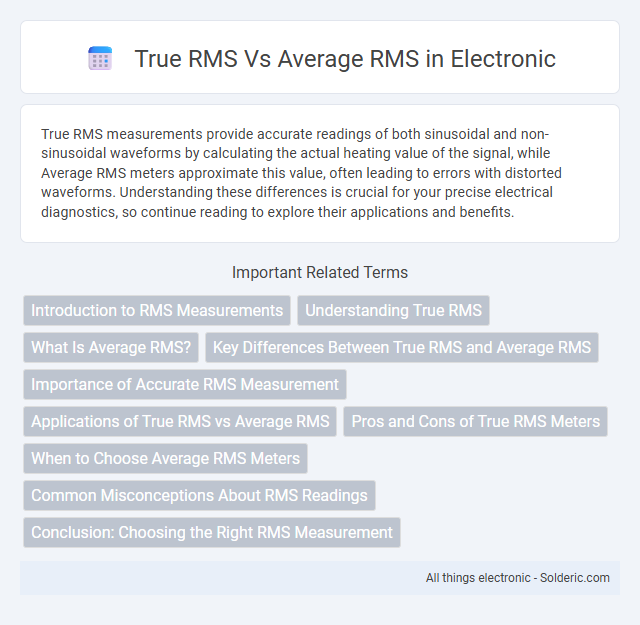True RMS measurements provide accurate readings of both sinusoidal and non-sinusoidal waveforms by calculating the actual heating value of the signal, while Average RMS meters approximate this value, often leading to errors with distorted waveforms. Understanding these differences is crucial for your precise electrical diagnostics, so continue reading to explore their applications and benefits.
Comparison Table
| Feature | True RMS | Average RMS |
|---|---|---|
| Measurement Type | Measures actual root mean square value of any waveform | Measures average rectified value, estimates RMS assuming sine wave |
| Accuracy | High accuracy on non-sinusoidal and distorted waveforms | Accurate only on pure sinusoidal waveforms |
| Use Case | Industrial equipment, electronic troubleshooting, complex signals | Basic AC voltage/current measurements, stable sinusoidal sources |
| Cost | Generally higher cost due to complex circuitry | Lower cost, simpler design |
| Waveform Compatibility | Compatible with sine, square, triangle, and distorted signals | Support mainly pure sine waves |
| Example Application | Testing variable frequency drives, motors, and distorted loads | Household electrical measurements, simple AC circuits |
Introduction to RMS Measurements
RMS (Root Mean Square) measurements quantify the effective value of an alternating current or voltage, essential for accurate electrical analysis. True RMS meters measure both sinusoidal and non-sinusoidal waveforms accurately by calculating the precise square root of the mean of the squares of instantaneous values. Average RMS meters estimate RMS based on the average rectified value, which can lead to errors with distorted or complex waveforms, making True RMS essential for your precise electrical diagnostics.
Understanding True RMS
True RMS meters accurately measure the effective voltage or current of any waveform, including distorted or non-sinusoidal signals, providing precise readings critical for complex electrical environments. Average RMS meters calculate the mean value of the waveform but assume a pure sinusoidal signal, leading to errors when measuring harmonics or irregular waveforms. Understanding True RMS is essential for electrical professionals working with variable frequency drives, non-linear loads, or electronic equipment where waveform distortion is common.
What Is Average RMS?
Average RMS measures the root mean square value of a waveform by calculating the average of the absolute values over a specific period, providing an estimation of signal power for non-sinusoidal waves. Unlike True RMS, it assumes a consistent waveform shape, which can lead to inaccuracies with complex or distorted signals. Average RMS is commonly used in simpler measurement tools where cost and complexity are concerns but may provide less precise results in variable signal conditions.
Key Differences Between True RMS and Average RMS
True RMS meters measure the actual root mean square value of a complex waveform, providing accurate readings for both sinusoidal and non-sinusoidal signals. Average RMS meters calculate the root mean square value based on the average rectified value, which can lead to errors when measuring distorted or complex waveforms. Understanding these key differences helps you select the appropriate meter for precise electrical measurements in various applications.
Importance of Accurate RMS Measurement
Accurate RMS measurement is crucial for precise electrical diagnostics and equipment performance analysis, as True RMS meters capture both sinusoidal and non-sinusoidal waveforms, ensuring reliable readings under complex signal conditions. Unlike Average RMS meters, which are calibrated for pure sine waves and can produce significant errors with distorted waveforms, True RMS provides your instruments with the exact root mean square value essential for proper load and power calculations. Ensuring accurate RMS measurement protects your equipment from malfunctions and helps maintain energy efficiency in modern electrical systems.
Applications of True RMS vs Average RMS
True RMS measurements accurately capture the effective value of complex, non-sinusoidal waveforms common in industrial equipment, variable frequency drives, and distorted power signals, making them essential for precise power quality analysis and electrical troubleshooting. Average RMS meters suffice for purely sinusoidal signals, such as steady AC power in residential or simple commercial environments, where waveform distortion is minimal and accuracy demands are lower. Choosing the right meter ensures your readings reflect true electrical conditions, enhancing diagnostic reliability and equipment safety.
Pros and Cons of True RMS Meters
True RMS meters provide precise voltage and current measurements for non-sinusoidal waveforms, making them ideal for complex electrical systems with harmonic distortions. They accurately capture fluctuating signals, but True RMS meters tend to be more expensive and consume more power than average-responding meters. Your decision to use a True RMS meter will depend on the importance of accuracy in varying signal conditions versus the cost and power efficiency constraints.
When to Choose Average RMS Meters
Average RMS meters are suitable when measuring signals with a consistent waveform, such as sine waves or stable AC voltages, making them ideal for basic electrical diagnostics and routine maintenance. They provide cost-effective, accurate readings for non-complex waveforms where true RMS accuracy is not critical. Your choice of an average RMS meter should align with applications where wave distortion is minimal and speed or simplicity is prioritized over precision.
Common Misconceptions About RMS Readings
Many users mistakenly believe that average RMS meters provide accurate measurements for all waveforms, but they only offer precise readings for pure sine waves. True RMS meters measure the exact heating value of any waveform, including distorted or non-sinusoidal signals common in modern electronic devices. Understanding the distinction ensures your measurements reflect true electrical conditions, avoiding potential errors in power assessments and equipment diagnostics.
Conclusion: Choosing the Right RMS Measurement
True RMS measurements provide accurate readings for both linear and non-linear loads, making them ideal for complex electrical systems with varying waveform shapes. Average RMS meters, while suitable for purely sinusoidal signals, can produce inaccurate results when dealing with distorted waveforms or modern electronic devices. Choosing the right RMS measurement depends on your application's waveform characteristics and the precision required for reliable electrical diagnostics.
True RMS vs Average RMS Infographic

 solderic.com
solderic.com